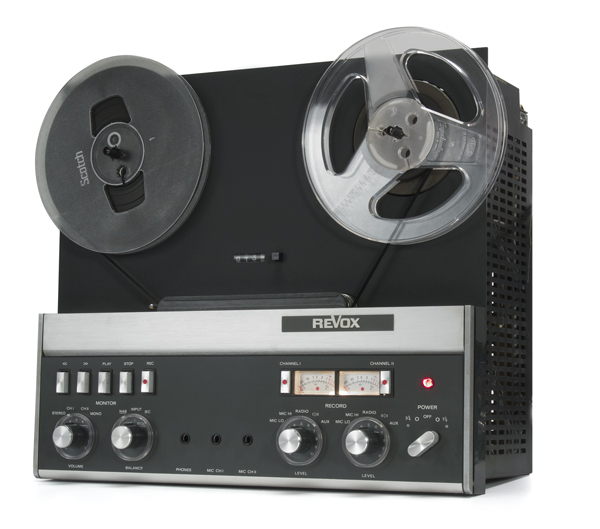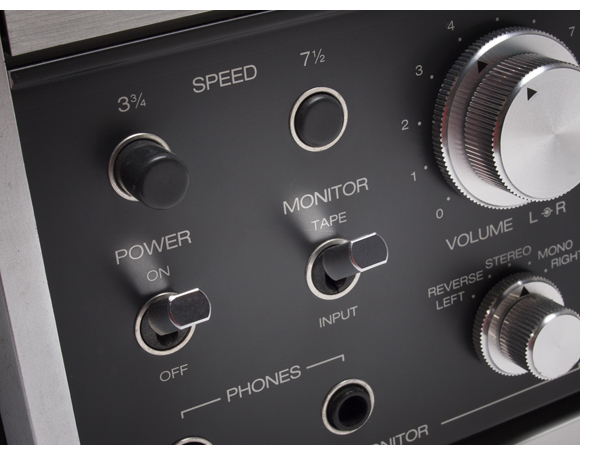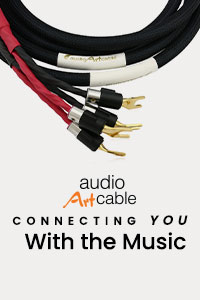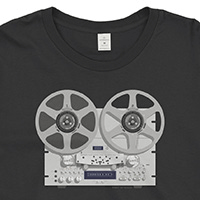Revox A77 and B77
 Along with the boom in killer headphones and headphone amps, the past few years have turned up another unexpected revival. It was clear to all – upon hearing the insultingly poor ear-buds supplied with iPods – that there was an opportunity to revitalize a moribund audio sub-genre. Stand-alone DACs, bad-ass Japanese direct-drive turntables, and a few others are enjoying rebirths, too. But who would have predicted a comeback for reel-to-reel tape?
Along with the boom in killer headphones and headphone amps, the past few years have turned up another unexpected revival. It was clear to all – upon hearing the insultingly poor ear-buds supplied with iPods – that there was an opportunity to revitalize a moribund audio sub-genre. Stand-alone DACs, bad-ass Japanese direct-drive turntables, and a few others are enjoying rebirths, too. But who would have predicted a comeback for reel-to-reel tape?
It never was a populist format, however often magazines like Playboy featured them in “bachelor pad” layouts in the 1950s and 1960s. They were owned mainly by the hard-core audiophiles of the day, those with 1) enough money to feed them open-reel tape, which never was affordable in the manner of the later cassettes, let alone CD-Rs, 2) no aversion to a conscientious handling regimen as irritating as that of LPs, and 3) an appetite or need for the ability to record. And costly pre-recorded open-reel tapes were always of limited appeal.
As for the comeback, it is primarily a high-end phenomenon. Opus 3’s astonishing pre-recorded tapes cost as much as 10 CDs or four audiophile LPs. Rebuilds and upgrading from specialists like Gold Sound and United Home Audio are serious investments. Finding blank tapes is such a chore now that even used tapes, to record over, have value: I saw a vendor selling used 10½in Maxells for $10 each at the recent AudioJumble in Southern England.
When tape recorders moved from tubes to solid state, the bulk and the weight reduced slightly, though the size of the tape reels a machine could handle determined how small it could go. But the cooler running and quieter operation made open-reel decks a shade more attractive, and the genre survived well-past the arrival of the cassette. But by the 1990s, you would see reel-to-reel machines mainly in systems belonging to those with vast libraries of tapes, or to anachrophiles who simply prefer archaic means of sound reproduction.
Among the most popular – and deservedly so – of the solid-state open-reel machines were the Revox A77 and B77. Like the equally coveted all-tube G36 that it replaced, the A77 launched in 1967 falls under the heading of “semi-pro,” and was equally popular at home and the studio. Pros loved them because they were compact and relatively portable.
A77s and B77s arrived in time for hi-fi’s period of greatest desirability, the mid-1960s to the late 1980s, and were the decks of choice among European audiophiles They vied mainly with Tandberg, Grundig, Uher or Ferrograph, while Americans had a greater affinity for Crown, Ampex, and select Japanese models from Sony, Dokorder, TEAC and Technics.
For most, though, Revox was the Rolex Oyster of tape decks, in every sense of the analogy: ruggedness, functionality, and exclusivity, but without insane pricing. Note that last bit: its status was not a matter of cost, as prices of upscale open-reel-tape decks were close from brand to brand, the main exception being the always-dearer Nagras. In 1986, for example, a B77 Mk II at $1999 was similar in price to a Sony or TEAC with 10½in spool capability.
As for Revoxes in retrospect (and as is the case with different versions of any vintage item), you will find not only factions for either A77s or B77s, you’ll even find those who prefer Mk I B77s versions over Mk IIs and vice versa, or A77 Mk IIIs over Mk IVs. As both A and B are closely related, the smart money would be placed on the later B77 as the model that may be the nicer to use in the modern era.
What the A77 delivered of its tubed predecessor, in addition to electronic instead of mechanical switches, silence and cool running, was a superior three-motor, direct-drive tape transport system. Its innovations included a capstan motor to drive the tape at constant speed, with the other two motors overseeing the tension of the feeder spool and constant tension for the take-up spool. Rewind and fast-forward speeds were exceptional, too, the winding was admirably smooth, and braking was electromagnetically servo-assisted.
Depending on your needs, pro or domestic, Revox offered quarter-track or half-track formats, and speed choices of 3¾ips/7½ips, or the high-speed 7½ips/15ips configuration. Variants also included half-track, quarter-track and slow-speed versions 1 7/8ips. Details included precise relay controls; accurately calibrated and illuminated VU meters; a four-digit tape counter; photo-electric end-of-tape switching; easy access to the heads for adjusting, cleaning or de-magnetizing; plug-in circuit boards for easy maintenance or upgrades; separate output for headphones with dedicated volume and balance controls; switchable EQ (NAB for recording and both NAB and IEC for playback), plus special features for editing. Inputs included switchable high/low Mic, Radio and Auxiliary.
Specs were remarkable for a machine measuring only 15½x16x7in, compared to console types found in studios. The signal-to-noise ratio was stated as better than 58dB at 7½ips and 56dB at 3¾ips, with crosstalk better than 45dB in stereo undistinguished by today’s standards, but a recent listen to master tapes on a mint B77 proved it to be more than good enough for “high end” usage.
After the A77 ended its run with Mk IV status, Revox unleashed the B77 in 1979/80. It was smoother to operate, better-sounding, more generously equipped, and more reliable. Revox built the B77 around an aluminum die-cast chassis. Like the A77, it housed three AC asynchronous motors, the capstan controlled by a tachometer head that read a series of pulses created by the teeth on the circumference of the motor, their rate compared against the frequency of an internal oscillator. This ensured superlative speed accuracy, while reducing wow and flutter. The A77’s relay controls were supplanted by transport controls overseen by solid-state logic.
A three-head machine like the A77, the B77 also had space to accept an optional fourth head, enabling the unit to be compatible with for slide-projector synchronization. Also provided by the B77 were sound-on-sound, adding echo or reverb to an existing track, “Duoplay” when both recorded tracks are used simultaneously but to play back different material, and “Simuplay” for synchronizing music on one track with speech on another. The Revox B77 also provided a splicing block with built-in cutter fitted to the front panel, audible tape shuttling and, in the Mk II, built-in vari-speed control +/-10%, equal to a pitch change of two semi-tones.
Slightly larger than the A77, it still occupied a space of only 17¾x16¼x8¼in. Performance gains over the A77 affected every area, from wow-and-flutter to crosstalk to S/N ratio. As far as I can gather, only one functional sacrifice was made when the A77 morphed into the B77, in that customers purchased the B77 with either NAB or IEC equalization, not both.
Like any vintage open-reel decks, all have suffered the ravages of time and wear; besides checking out the electronics, tape decks have mechanical elements that need replacing, and tape head wear is a primary concern. What makes the Revoxes so appealing is that they shared much with their Studer-badged professional siblings, so they’re more rugged than most. And sonically, they are among the most domestically-acceptable open-reels – by that, I mean in terms of price and dimensions – that can ape the brilliant sound that keeps so many exhibitors at recent hi-fi shows demonstrating with open-reel tape.
Some might think that there may be a US-vs-Europe divide at play, and I appreciate that many brands use hot-rodded TEAC/TASCAM or Technics reel-to-reels at shows. Conversely, a number use Nagras, which – like the Revoxes – are as Swiss as William Tell. Comparing eBay.com with eBay.co.uk reveals similarities in pricing, too: parts donors from under $100 to good, median buys for $500 and perfection for $1000.
Revox users are well-supported by specialist repair services, particularly for spares. Dedicated web sites can provide information ranging from servicing, such as www.revox.freeuk.com, to hot-rodding, as well as sourcing fully-refurbished machines beyond those you might find on eBay. We heartily recommend a few evenings studying the lore on www.taperecorder.co.uk and www.reeltoreel.de/worldwide/B77.htm before you go crazy with eBay. Pub. Note: For our Stateside readers, I suggest perusing www.tapeheads.net as well.
Whatever route you might pursue, the Revox’s style, reputation, build-quality, smooth operation, configuration options, and ergonomic brilliance, and – it must be added – sheer “Swissness,” captured the hearts of many thousands of aficionados. Enjoy one for an evening and you’ll hear why. -Ken Kessler







